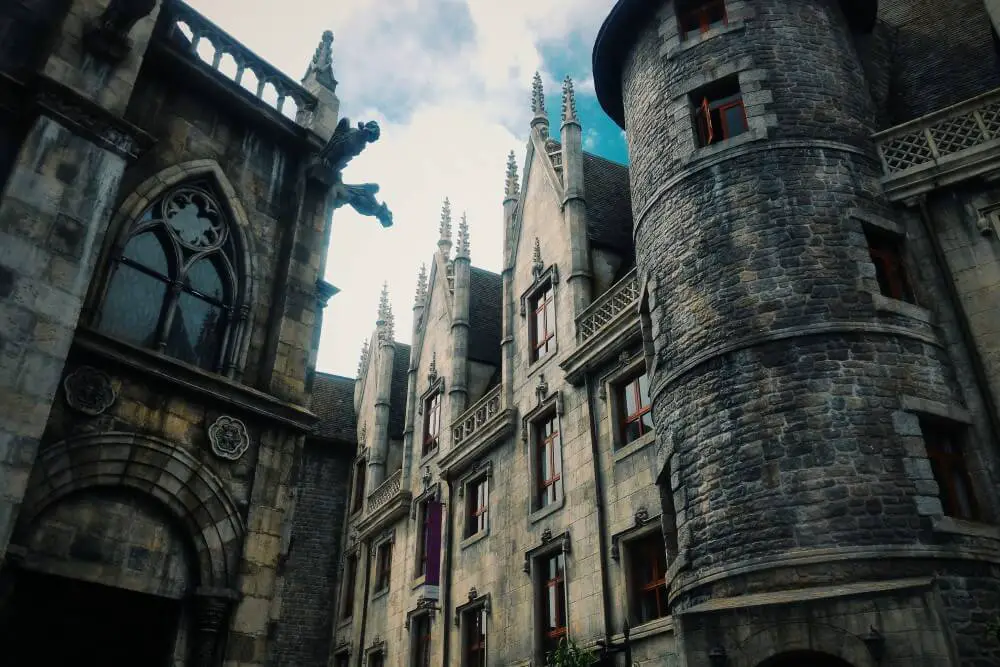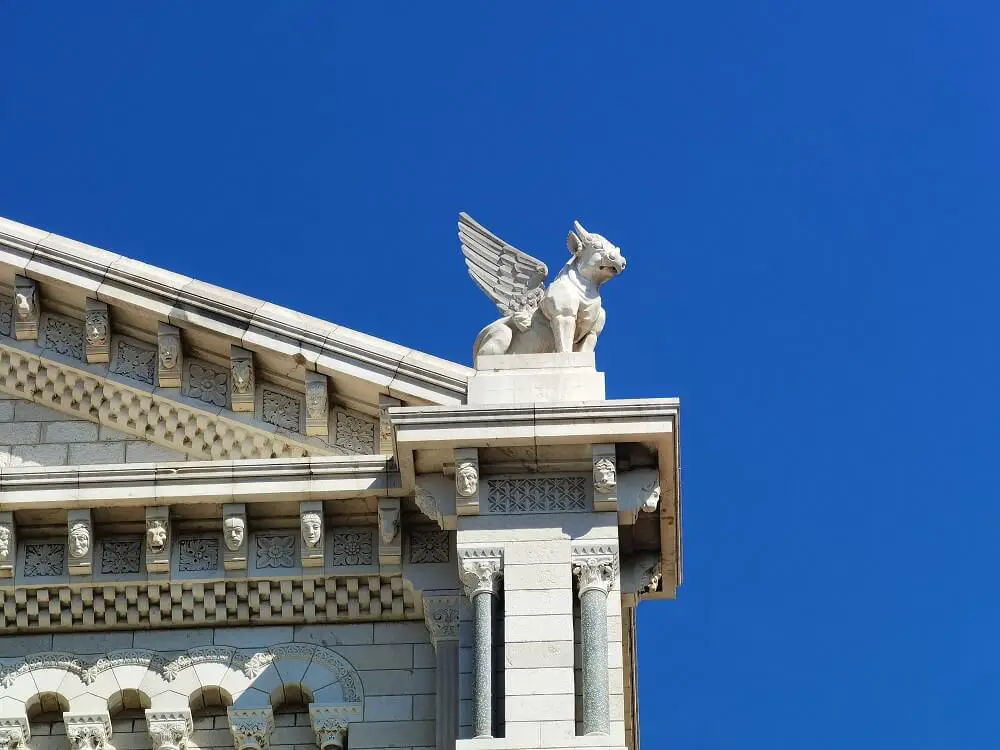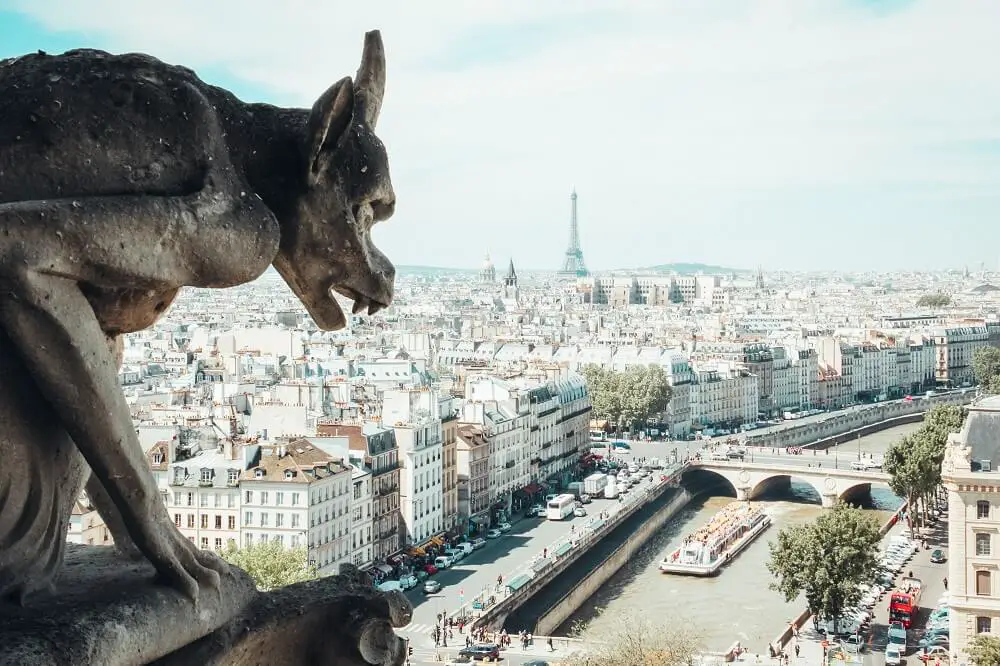There’s little doubt that two of the most enchanting types of man-made structures to be found anywhere are churches and cathedrals. And one of the main reasons why they capture the imagination is their prevalent use of architectural elements like gargoyles.
While gargoyles were used on a range of medieval buildings, they have come to be most closely associated with churches and cathedrals. With their intricate details and mesmerising gazes, they have stood as both guardians and symbols of mystery, adorning sacred structures for generations.
But many an observer or visitor to the world’s many such stunning religious buildings may be wondering the same thing: why are gargoyles used on churches? It’s an interesting question that has a multi-faceted answer.
But first, let’s explain what the definition of gargoyle is in the first place:

What is a gargoyle?
A gargoyle is a carved stone creature, typically made from materials like granite, that adorn the roofs, battlements, and parapets of buildings, particularly those of Gothic architecture. Over the centuries, various cultures have utilised gargoyles, which often take the form of animals like lions, dogs, wolves, goats, and even combinations of human and animal, known as chimeras.
The term ‘gargoyle’ finds its origins in the French word ‘gargouille’, which means ‘throat’ or ‘gullet’. This name likely stems from the gurgling sound produced by the flowing water as it passes through the gargoyle and out of its mouth.
But while the term ‘gargoyle’ originally referred specifically to functional water-spouting sculptures, its meaning has broadened to encompass ornamental figures now seen on churches and cathedrals. This has led to a distinction between true gargoyles, which have a practical water-management purpose, and the purely decorative varieties known as grotesques, chimera, or bosses.
Some of the most famous examples of gargoyles on cathedrals include Notre Dame in Paris, the Duomo in Milan and Washington National Cathedral in Washington, D.C. These remarkable stone sculptures serve as an enduring testament to the intricate fusion of artistry, symbolism, and practicality within architectural history.
What is the purpose of a gargoyle?
The primary purpose of a gargoyle is to channel rainwater away from the sides of structures, preventing the risk of mortar erosion and damage to structural elements. However, gargoyles also have a function as a purely decorative element, owing to their unique visual aesthetics.
Originally, the gargoyle was designed to act as a spout that directs rainwater from the upper portions of buildings or roof gutters. To achieve this, gargoyles were designed with a trough carved into their back, allowing rainwater to flow down through it.
Then, in a typical gargoyle design, water exits the gargoyle through its large, open mouth, which is usually one of its defining features. This efficiently diverts rainwater away from the building’s walls and foundations, contributing to the preservation of the structure over time.
So now we know the primary reason why gargoyles are employed on buildings, let’s discover they are used specifically on churches and cathedrals…
Why are gargoyles used on churches and cathedrals?
Gargoyles are used on churches and cathedrals for a combination of reasons, including their practical functionalities, connection to religious symbols and cultural significance.
Let’s explore some of the main reasons in more detail.
Practical Function
Originating from the ancient Greek and Egyptian civilisations, gargoyles were adapted by Gothic architects to serve as downspouts that directed rainwater away from the foundations of churches and cathedrals. While the first gargoyles were simple stone channels, over time, they evolved into elaborately carved creatures with troughs on their backs, allowing rainwater to flow through and exit their open mouths.
This ingenious design prevented erosion of mortar and damage to the masonry of such structures as churches and cathedrals.
In medieval times, it was particularly important to prevent such damage, since churches were invariably both the biggest and most significant buildings in any given urban area at the time of their construction. As such, it would’ve been much harder to address water damage than it would be today.

Symbolism and Religious Significance
However, the purpose of gargoyles extended beyond mere functionality. For many centuries, these grotesque figures held profound symbolism that reflected the religious and societal values of the time.
For instance, during the Gothic Age, when most people were illiterate, churches employed visual imagery to warn against immorality. Gargoyles, along with statues of angels and saints, were strategically placed to juxtapose good and evil in stone form, imparting lessons to the masses.
With their twisted and deformed features, gargoyles symbolised the grotesque and the repulsive, serving as tangible reminders of the dangers of sin and the evil that lurked beyond the church walls.
Indeed, in some cases, gargoyles were designed to imitate pagan creatures, creating a bridge between the pagan beliefs of the past and the burgeoning Christian faith. This strategy was intended to make the church seem more inviting to those who practised pagan religions, potentially facilitating conversions to Christianity.
Protection and Sanctuary
Meanwhile, one of the other pieces of folklore that often surround gargoyles are their protective capabilities. While not a primary religious doctrine, these legends purport that gargoyles help to guard the sacred space of the church, keeping evil spirits at bay.
This protective symbolism added to the sense of sanctuary that the church offered its worshippers. Although just a legend, it further exemplifies the use of gargoyles as a mixture of practicality, symbolism, and a desire to guide and educate the masses through visual storytelling.
That’s it for our guide to why gargoyles appear on churches and cathedrals. As we have seen, these stone symbols are a fascinating architectural element that have been rightly appreciated and preserved across the world’s famous Gothic structures.
Want to find out more about the world of construction and architecture? If so, explore our selection of related articles, featuring our informative guide to whether we will continue to build in the Gothic style.
Or, if you’d like more definitions on building and architecture vocabulary, take a look at our selection of building wikis. For instance, discover more about another commonly found architectural church feature with our guide to flying buttresses.
Last Updated on 24 August 2023 by Michael
